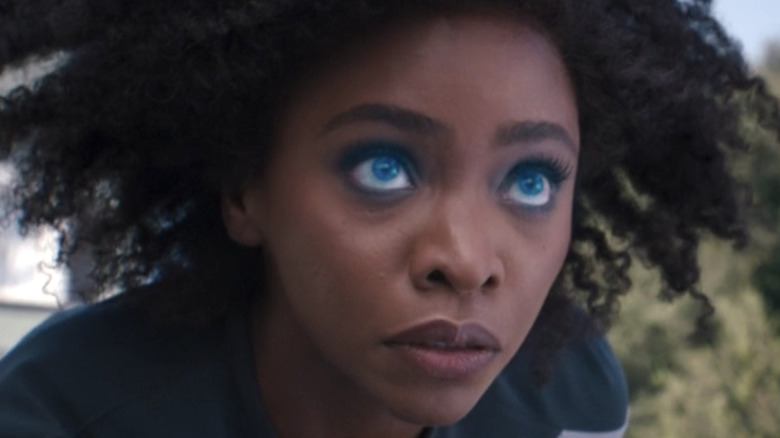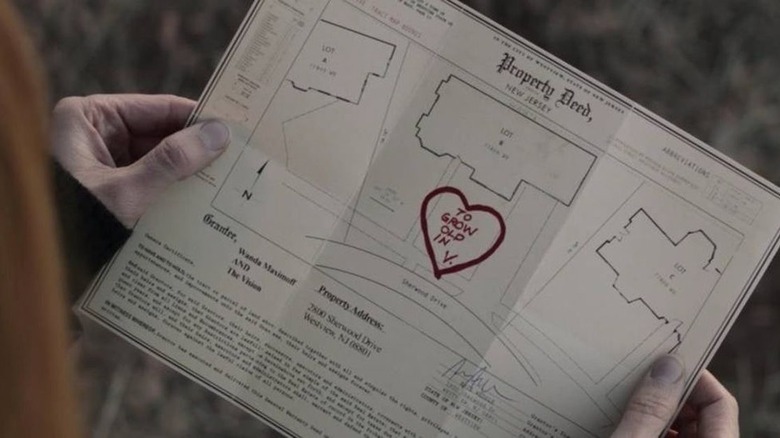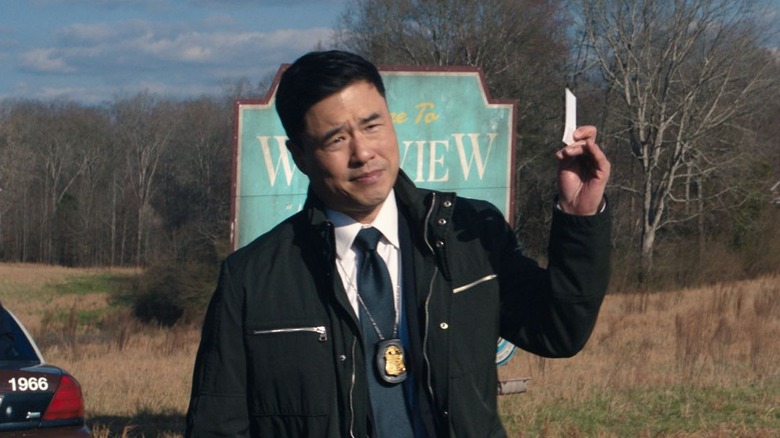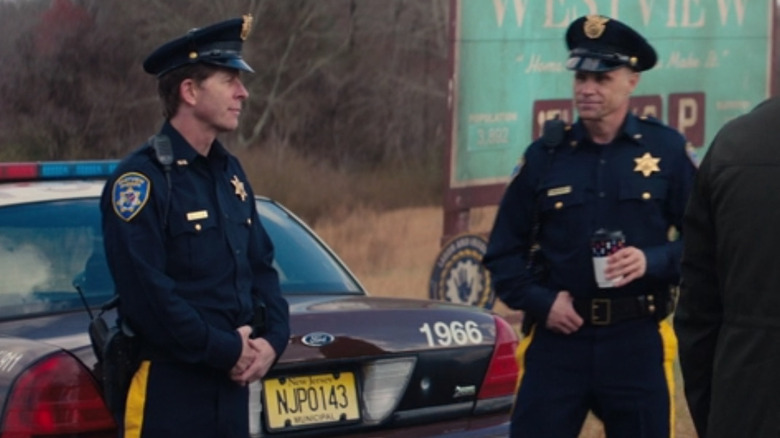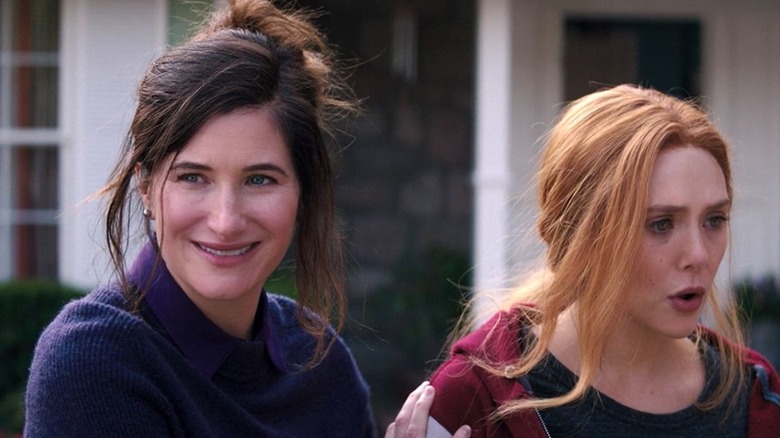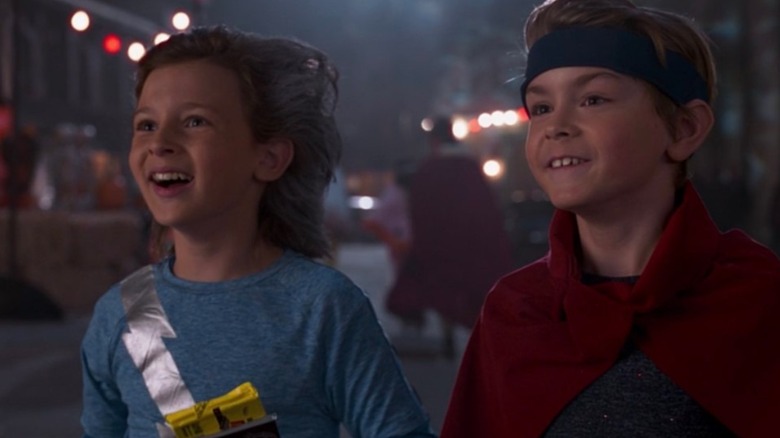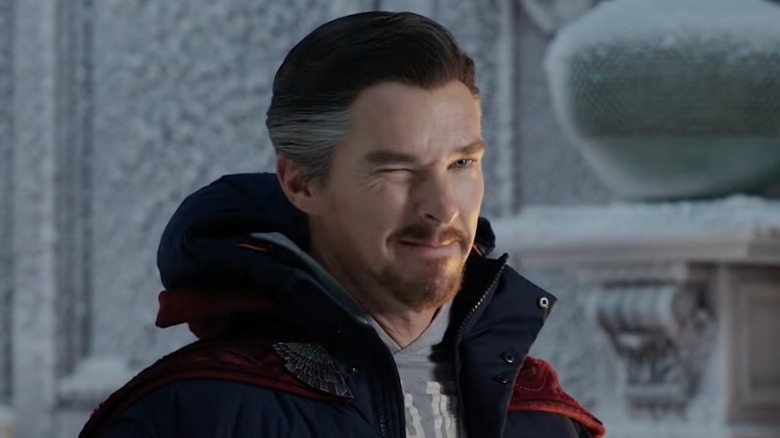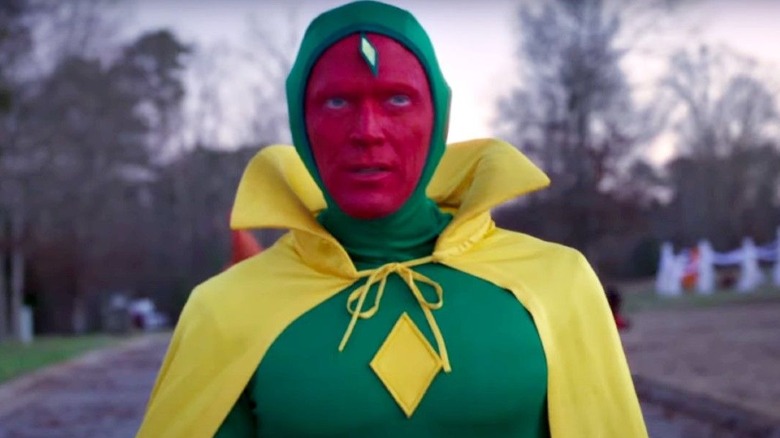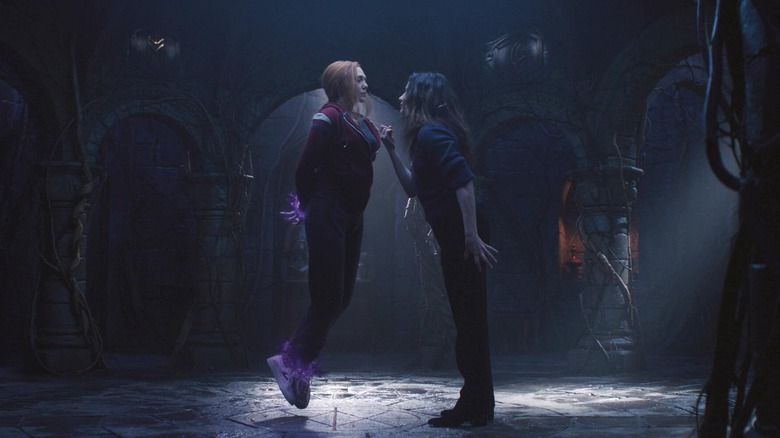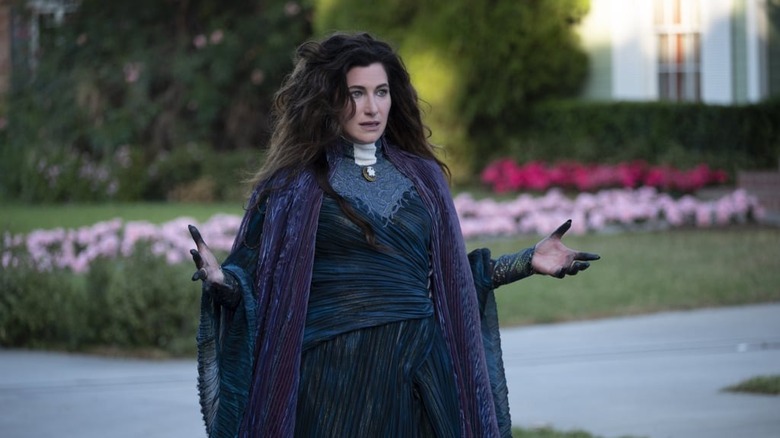10 Things That Make Absolutely No Sense In WandaVision
It all comes back to those polar bears.
When "Lost" premiered on ABC in 2004, it permanently changed television. Its scope was unheard of; its story, singularly dazzling. Here was a show that stacked mysteries like Jenga blocks, but was seemingly so well built that collapse was out of the question, right? And it's questions definitely had answers — right?
The answer: Yes. Well, sort of. "Lost" kickstarted the modern "mystery-box" TV show by, ironically, not planning out its mysteries. Those polar bears that attacked Kate and Sayid? Explained, but barely. Walt's supposed superpowers? Nope, not at all. In an interview with Yahoo Entertainment, Abrams noted that explaining every detail becomes "like the briefcase in 'Pulp Fiction.' If you show me what's in there, I promise you it will disappoint me." Fair enough. But when lingering questions about the world of a show disrupt or sabotage its emotional logic, the disappointment is doubled.
Such was the case, sadly, with "WandaVision." To be clear: I think Jac Shaffer and Matt Shankman's Disney+ show is one of the year's finest. I also think it stops short of being a masterpiece. Though "WandaVision" is (more often than not) a satisfying example of obfuscation for storytelling's sake, there are pieces of its narrative that come to nothing. Here are 10 things that don't make absolutely no sense in "WandaVision."
Why and how did Vision pick Westview?
Wanda and Vision desire domestic bliss. It's an understandable impulse — their time as a couple has been marked by imprisonment, loss, and grief. So, when the 8th episode of "WandaVision" (entitled "Previously On") reveals that Vision purchased a deed of land in Westview, New Jersey for the couple "to grow old in," it is heartbreaking. Now, Vision is gone. On the land where they were supposed to live together, Wanda can only build a home out of her pain and anger.
However: Vision's decision raises a few confounding questions. First: Why Westview? It's rundown and not that hospitable. If Westview declined post-blip (and was better off when Vision purchased the deed), that could have been clearer. If Vision's decision was financially motivated (i.e. he lacks the funds for more than Westview — "The Falcon and the Winter Soldier" reveals that Avenging doesn't pay all that well), that would've made his purchase more poignant. What's more, the sitcoms that Wanda adored as a child weren't set or filmed in New Jersey, and it's not that close to the Hudson Valley Avengers Compound. For such a pivotal decision, Vision's choice of Westview feels far too random.
What happened to Jimmy Woo's missing person case?
Jimmy Woo is obsessed with the details. That's why Scott Lang's magic trick puzzles him to the point where he must learn it. That's why he sees through Tyler Hayward and his gross abuses of S.W.O.R.D. Sweating the small stuff makes Woo one of "WandaVision's" most endearing characters — which is why the missing person case that brought him to Westview doesn't add up.
Remember that missing person case? In episode four of "WandaVision," "We Interrupt This Program," Jimmy meets Monica Rambeau outside of Westview and informs her that someone in the town has gone missing. As this person is in the Witness Protection Program, there's no telling who it actually is. It sounded like Woo's contact would be important to the overarching plot of "WandaVision." As it turns out, they couldn't matter less.
The good news: Jimmy Woo's missing person is, allegedly, still coming to the MCU. The bad: Everything we know about Jimmy Woo indicates that ensuring the witness' safety would be of paramount importance to him. Even if the witness will be revealed later in Marvel's Phase Four, the fact that we don't see Woo follow up on their status by the show's end both leaves his character arc frustratingly incomplete and feels entirely out of step with the core of who Agent Woo is.
Where did the Eastview cops go?
The previously mentioned meeting between Woo and Rambeau contains another head scratcher. After mentioning his missing witness, Woo shuffles Rambeau towards two loitering cops. Their claim: Westview doesn't exist. Further interrogation yields that the police officers work in the never-again-mentioned Eastview. Clearly, something's up.
But what? Before Woo and Rambeau approach the cops, we hear one of them whisper "Here we go," suggesting that their stonewalling is deliberate. Frustratingly, neither of the cops is seen again. We also hear (but don't see) them drive their squad car back into Westview, yet the hex remains undisturbed. Lastly, the car — which could only be driving straight back into town, based on the geography presented — is nowhere to be seen when Woo and Rambeau look back at the town. If you suspected that something weird was going on, a disappearing car would be a huge clue. Similarly, if Wanda could manipulate Westview citizens outside of the hex, wouldn't it be in her interest to do so, belaying the world's suspicions?
If this is all making your head spin, it should. The cops are one of "WandaVision's" most confounding mysteries — and not in a fun way.
What function did the sixth commercial serve?
There are many theories surrounding the commercials in "WandaVision." Initially, the ad breaks during Wanda's sitcom broadcast revealed both buried and known truths. There were allusions to Tony Stark and HYDRA. There were direct mentions of Lagos, the city where Wanda accidentally slaughtered innocents. These commercials appeared to be either an outside party or Wanda's own subconscious leading her back towards reality. "Yo-Magic Yogurt," the sixth commercial that airs in "WandaVision," muddles either scenario.
While "Yo-Magic Yogurt" is one of the show's aesthetic highlights (a dizzying blend of stop-motion animation and '90s references), it also makes no sense. "Yo-Magic Yogurt" finds a boy stranded on an island who's so hungry he'd eat anything. Enter a surfing shark who offers the boy some Yo-Magic yogurt. When the boy is unable to remove the yogurt lid, he withers away into a skeleton and dies. It's deeply disturbing!
But for what purpose? Is this ad meant to indicate that Quicksilver (a boy) could've survived Sokovia if he had Wanda's magic? Is it a deeply buried suggestion that Vision will disappear as soon as Wanda's hex does? What's more, every ad that airs up until this point takes another chronological step through Wanda's life. But "Yo-Magic Yogurt" stands alone. Given that it has little impact on the eventual endgame, trying to understand "Yo-Magic Yogurt" is a fool's errand.
Why does Wanda's accent come and go?
"My, that accent really comes and goes, doesn't it?" So jabs Agatha Harkness during "WandaVision's" penultimate episode, making a dig not only at Wanda but at MCU continuity. Like Halle Berry in the "X-Men" films, Elizabeth Olsen was saddled with a tricky accent for Wanda's first on-screen appearance. Over time, the accent receded towards a more standard American vocalization, and the damage was done. Memes were made; continuity was established. And then, the sudden reemergence of Wanda's accent in "We Interrupt This Program" made it an unexpected plot point. Why had it returned? Did it reveal anything about Wanda's mental state?
Unfortunately, we never got an answer. Like many elements of "WandaVision," the ins and outs of Wanda's Sokovian speech patterns amount to little more than a wink and a nod. Prior to this show, Wanda had no history of struggling with her accent. Its appearance doesn't clearly correlate with Wanda's emotions (it shows up, for example, when Wanda is under duress with Agatha, but not when she sees the Vision's corpse). Wanda's accent didn't need clarifying, but given how precise a portrait "WandaVision" paints of Wanda's grief and how it manifests, its jumbled presentation is a confusing, missed opportunity.
What actually happened to Westview's children (if anything)?
Early in "WandaVision's" run, there's a throwaway line from Agatha that stuck with me: "Kids, you can't control them." It seemed to answer the show's largest mystery: why there were no children anywhere in Westview. If Wanda was, in fact, manipulating the entire town's population through intensive mental projection, the less developed minds of children could hinder her plans. It's interesting, then, that a whole swath of children emerged for the show's "Halloween Spooktacular!" episode — and while it was impossible to suss out whether they were Wanda's projections or were released by a malevolent force, the development indicated that the presence of children — or the lack thereof — was important.
Except it wasn't. While Tommy and Billy's fate is heartbreaking, whether or not Westview had any children makes less sense the more you think about it. In the glimpses we get of a hex-free Westview, there are no kids. And while that's actually a fascinating idea (did the blip only affect Westview's children?), it doesn't appear to be purposeful. What's more, we never learn where all those kids out trick-or-treating came from. "WandaVision" used children for some major foreshadowing, only to leave the final answer completely opaque.
Where was Doctor Strange?
If you found it odd that Dr. Strange never showed up at any point in "WandaVision," don't worry — he was meant to! Apparently, the Sorcerer Supreme would've made an appearance in the Disney+ show if not for some last minute changes. As Kevin Feige explains, "Some people might say, 'Oh, it would've been so cool to see Dr. Strange.' But it would have taken away from Wanda. We didn't want the end of the show to be commoditized to go to the next movie — here's the white guy, 'Let me show you how power works.'"
To be 100% clear, this is both a noble and necessary gesture. If Marvel's shows continually hinge on white male protagonists, even obliquely, then they're failing to tell diverse stories. That being true, it's also noteworthy that Doctor Strange isn't even mentioned during "WandaVision." The end of "Avengers: Endgame" positions Strange as a public figure, if not the world's first line of defense against dark forces. A magical hex that's taken over an entire town surely qualifies. It's radical that not a single member of S.W.O.R.D. even considers contacting Strange (though it's easy to imagine why Director Heyward would resist that decision), and a choice that qualifies as nonsensical.
How can Vision act against Wanda's wishes?
"WandaVision" gives and it takes. On the one hand, once Vision begins exploring the inconsistencies of his idyllic suburban home, the show's narrative goes into overdrive. On the other, what Vision can see and becomes capable of undoing doesn't track as satisfyingly as one might hope.
Let's be clear: Vision is a manifestation of Wanda's grief. She did not steal or reanimate his body. His soul is not somehow living through hers. So, when Vision is pushing at the edges of Wanda's fantasy, it's really Wanda disrupting her own manifestation. Therefore, it isn't clear why and how Vision is able to upset the balance of what Wanda's built, nor is it clear why he can see when it frays.
For example, if Wanda's vision (pun intended) grows less powerful towards the edges of Westview — a limitation that manifests in the form of people glitching — why doesn't Vision glitch the farther out he gets? It's not that there aren't possible answers here, as much as that the ones offered don't fit with Wanda's emotional arc. That makes no sense.
How do the runes work, exactly?
In "WandaVision's" final episodes, Wanda becomes aware of runes. They have been etched in Agatha's basement, rendering Wanda's magic useless; she knows nothing of their power. So when, in the show's final moments, these runes prove to be Agatha's downfall, it's a nifty bit of storytelling. Although it takes a lot of exposition, Agatha's monologue reveals that her Achilles heel is hubris. She can't help but share her gifts — and in the end, that's her undoing.
The undoing itself is confusing, though. In the finale, Wanda casts the runes, throwing the villainous witch's powers into disarray. According to Agatha, a witch's powers are useless when the right runes are cast. Why, then, is Agatha able to remain flying and in control for so long? Is the Scarlet Witch simply toying with her? Do the runes need time to take effect? It's important for the narrative thrust of the battle that the symbols become a runes ex machina of sorts, but they do so in spite of the show's internal logic. Given that "WandaVision" winds up being about how Wanda becomes the Scarlet Witch (and how being so is the crux of her personal identity), this deserves to be clearer.
How is Agatha imprisoned if Westview is free?
After Wanda defeats Agatha, she doles out her own twist on justice, imprisoning Agatha both in Westview and in the role she chose: that of the nosey, gossiping neighbor, Agnes Bohner. It's a startling moment. Agatha reverts almost instantaneously back into a wise-cracking gossip, the pain behind her eyes still obvious. As an end to Agatha's arc, this resolution feels sound. As an act of logical storytelling, though, it makes almost no sense at all.
A spell like this can't work if Wanda's runes aren't active, can it? If the runes that Wanda cast are still active and somehow just invisible, are they still affecting Westview? If not, what specifically is keeping a reality-bending witch like Agatha imprisoned? It's another decision that satisfies the needs of characters, but one that also undoes the seemingly delicate world building that "WandaVision" constructed — a pitfall in these mystery-box shows that is, unfortunately, all too common.
